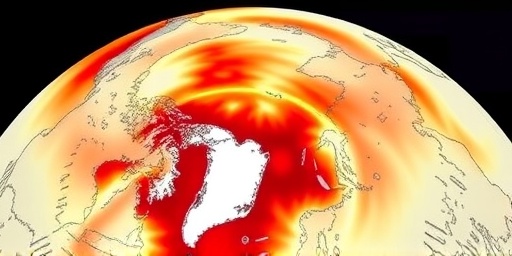In a stark warning for the planet’s future, satellite observations from the National Oceanic and Atmospheric Administration (NOAA) have confirmed that Arctic sea ice reached its lowest extent for November on record. This alarming development, announced this week, underscores the relentless pace of climate change and global warming, with scientists now predicting ice-free Arctic summers as early as 2030 if current trends persist. The data paints a picture of a rapidly melting polar region, raising urgent concerns about rising sea levels, disrupted weather patterns, and irreversible ecological damage.
- NOAA’s Alarming Satellite Revelations on Arctic ice Decline
- Accelerated Projections: Ice-Free Arctic Summers Loom by 2030
- Global Warming’s Broader Ripple Effects from Shrinking Arctic Ice
- Experts Demand Swift Policy Overhauls in Response to NOAA Findings
- Pathways Forward: Mitigating Arctic Ice Loss and Building Resilience
NOAA’s Alarming Satellite Revelations on Arctic ice Decline
The latest figures from NOAA’s satellite monitoring program show that the Arctic sea ice extent in November 2023 measured just 9.08 million square kilometers, shattering the previous record low set in 2012 by a margin of over 100,000 square kilometers. This isn’t a one-off anomaly; it’s part of a decade-long downward spiral in Arctic ice coverage. NOAA climatologist Dr. Jessica Sullivan explained in a press briefing, “We’ve crossed a threshold. The Arctic is warming at nearly four times the global average rate, and this November’s data is a clear signal that global warming is outpacing our worst-case scenarios.”
These measurements come from passive microwave sensors aboard satellites like NASA’s Aqua and Defense Meteorological Satellite Program platforms, which provide daily snapshots of ice-covered ocean areas. The technology detects the difference in microwave emissions between open water and ice, offering reliable data even through clouds and darkness. According to NOAA’s annual Arctic Report Card, released alongside these findings, the ice’s thickness has also thinned dramatically, with multi-year ice— the sturdy, older ice that survives summers— now comprising less than 10% of the total, down from over 50% in the 1980s.
This decline is exacerbated by a feedback loop: As Arctic ice melts, it exposes darker ocean waters that absorb more sunlight, accelerating the warming process. In November alone, air temperatures across the Arctic were 2-3 degrees Celsius above the 1981-2010 average, per NOAA records. The implications ripple far beyond the poles, influencing jet streams and potentially intensifying extreme weather events like heatwaves and storms in mid-latitudes.
Accelerated Projections: Ice-Free Arctic Summers Loom by 2030
Once considered a distant threat, the prospect of an ice-free Arctic Ocean during summer months now feels perilously close. A study published in Nature Climate Change, drawing on NOAA data, revises earlier estimates from 2050 to as soon as 2030 under moderate emissions scenarios. Lead author Dr. Mark Serreze from the National Snow and Ice Data Center stated, “The data doesn’t lie. If we hit ice-free conditions that early, we’re looking at a transformed planet— one where the Arctic’s role as Earth’s air conditioner is severely compromised.”
Historical context reveals the speed of this change. In the 1970s, November Arctic ice extent averaged around 11.5 million square kilometers; today, it’s plummeting toward single digits. NOAA’s long-term records, spanning over four decades, show a 13% per decade decline in September minimums— the seasonal low point. This year’s November low aligns with that trend, but its severity has prompted modelers to update projections. Using ensemble climate models, researchers now forecast that even with aggressive emissions cuts, the Arctic could see its first ice-free September by the late 2030s. Without action, perennial ice— present year-round— could vanish entirely by mid-century.
The acceleration ties directly to climate change drivers: rising greenhouse gas concentrations, primarily from fossil fuel combustion. NOAA attributes 75% of the observed warming to human activities, with methane releases from thawing permafrost adding fuel to the fire. These projections aren’t abstract; they’re backed by empirical evidence from buoys, submarines, and aircraft surveys that confirm accelerating melt rates.
Global Warming’s Broader Ripple Effects from Shrinking Arctic Ice
The vanishing Arctic ice isn’t an isolated crisis; it’s a harbinger of widespread global warming impacts. Sea levels, already rising at 3.7 millimeters per year according to NOAA tide gauges, could surge by an additional 0.5 meters by 2100 if polar ice sheets destabilize further. The Arctic’s melt contributes directly through freshwater influx, which slows the Atlantic Meridional Overturning Circulation— the ocean conveyor belt that regulates Europe’s climate. Disruptions here could lead to colder winters in North America and Europe, even as the globe heats up.
Weather patterns are shifting too. The loss of reflective ice amplifies the Arctic amplification effect, weakening the polar vortex and allowing cold air to spill southward more frequently. Recent examples include the 2021 Texas freeze and Europe’s 2022 heat dome, both linked by NOAA researchers to Arctic influences. Biodiversity suffers as well: Polar bears, reliant on sea ice for hunting, face population crashes, with NOAA estimating a 30% decline in key subpopulations by 2050. Walruses and seals, too, are forced onto shrinking ice floes, disrupting migration and breeding.
Economically, the stakes are high. The opening Arctic— with its vast untapped oil, gas, and mineral reserves— attracts shipping routes and resource extraction, but at great risk. Increased vessel traffic heightens oil spill dangers in a fragile ecosystem, while coastal communities in Alaska and Canada brace for erosion from storm surges unbuffered by ice. Indigenous groups like the Inuit report traditional hunting grounds vanishing, threatening food security and cultural practices. A report from the Arctic Council, informed by NOAA data, warns of $100 billion in annual global economic losses by 2050 from these cascading effects.
Experts Demand Swift Policy Overhauls in Response to NOAA Findings
In light of NOAA’s revelations, climate experts are sounding the alarm for immediate action. Dr. Jennifer Francis, a prominent atmospheric scientist, urged at a UN climate forum, “This record-low Arctic ice is our wake-up call. Governments must phase out fossil fuels now, invest in renewables, and protect the poles through international treaties.” The call echoes demands from the Intergovernmental Panel on Climate Change (IPCC), which in its latest assessment stresses that limiting warming to 1.5°C requires halving emissions by 2030.
Policy recommendations include expanding marine protected areas in the Arctic, currently covering only 2% of its waters, per NOAA advocacy. The U.S. could lead by rejoining and strengthening the Paris Agreement commitments, while pushing for a global methane pledge. On the domestic front, the Inflation Reduction Act’s clean energy incentives are a start, but experts like those at the World Resources Institute call for tripling investments to $4 trillion annually worldwide. International cooperation is key: Russia’s Arctic militarization complicates efforts, yet forums like the Arctic Council offer platforms for dialogue.
Grassroots movements are amplifying the urgency. Activists from groups like 350.org cite NOAA data in campaigns for divestment from oil giants operating in the Arctic. Meanwhile, technological innovations— such as reflective materials to mimic ice’s albedo or AI-driven monitoring— hold promise, but only if scaled through policy support. The European Union’s Green Deal, aiming for net-zero by 2050, serves as a model, integrating climate change adaptation with mitigation.
Pathways Forward: Mitigating Arctic Ice Loss and Building Resilience
As the world grapples with this new reality, hope lies in proactive measures. NOAA’s upcoming initiatives include enhanced satellite constellations for real-time ice tracking and collaborative research with indigenous knowledge holders to inform adaptive strategies. International summits, like COP29 in 2024, will spotlight Arctic issues, potentially yielding binding commitments on emissions and conservation.
Individuals can contribute by supporting carbon pricing, reducing personal footprints, and advocating for leaders who prioritize science. Businesses face pressure to decarbonize supply chains, with investors eyeing ESG criteria that penalize Arctic polluters. Long-term, restoring sea ice through geoengineering— like pumping seawater onto floes to thicken them— is under study, though controversial due to unknowns.
Ultimately, the record-low Arctic ice levels detected by NOAA demand a unified global response to curb global warming. By acting decisively, we can avert the most catastrophic outcomes, preserving the Arctic as a vital component of Earth’s climate system for generations to come. The window is narrowing, but it’s not closed— yet.









